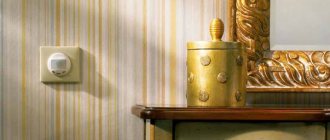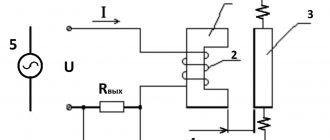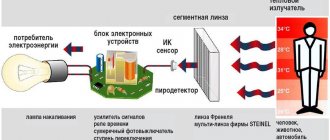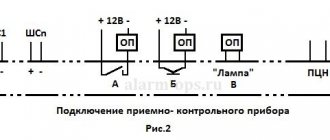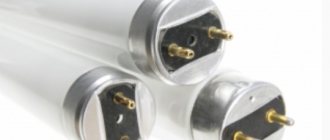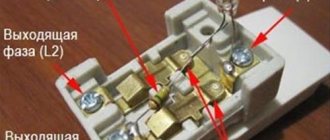Where used, types
Products come in several types - ceiling, wall and for hidden installation. They are also conventionally divided into several types according to the principle of operation (we will discuss this in more detail below).
When choosing, consider the installation location. Sensors are divided into household and street lighting.
In the latter case, materials are used that protect the device from negative natural influences. It can be connected on the stairs or on the street. Household devices are designed for installation inside the house.
Depending on the circumstances, sensors that monitor movement can be connected to a spotlight, lamps, or even an Arduino smart home.
The main device manufacturers are ERA, Evan, TDM, LLT, Orbis, Duwi, Camelion, Brennenstuhl, Elektrostandard, FERON, REV, REXANT, Rubetek and others.
Types of motion sensors
There are many types of motion sensors. It all depends on where they will be used. They are all divided into:
- infrared or passive
- microwave or active
- ultrasonic
- acoustic
- combined or dual
They can also be divided into external and internal.
Characteristics
When purchasing a motion sensor, it is important to consider a number of parameters, which determine the features, connection location, and conditions for use.
Main characteristics when choosing:
- WEIGHT. Modern light sensors weigh from 25 to 240 g.
- Maximum load power. When choosing a product, you need to look at the permissible load. Thus, one sensor can switch devices with power from 60 to 2300 W. Please note that when using more powerful devices, it may be necessary to replace the wiring or install a machine with a higher rated current.
- VOLTAGE. The operating voltage varies in a wide range from 1.5 to 220 Volts. Conventionally, motion sensors are divided into several groups - 1.5 V, from 2.2 to 3.6 V, 220 V, 5 or 9 V.
- MAXIMUM VIEWING ANGLE. Here the range is from 30 to 360 degrees. In the latter case, the device operates along the entire perimeter of the room.
- RANGE. The minimum and maximum distance parameters are 8 and 120 m. Here you need to take into account the object on which lighting is provided. You should not choose sensors with an excessively high parameter, because they can react to the movement of strangers.
- RECOMMENDED INSTALLATION HEIGHT. Here the permissible parameter ranges from 1.2 to 16 m.
- PRESENCE OF LED INDICATOR. Some sensors are equipped with an LED that starts blinking when a signal is present. Other LED display options are also possible.
These are the main characteristics that you need to consider when purchasing. We will discuss the selection criteria in more detail below.
Adjustment (setting)
After installation, the motion sensor must be configured to turn on the light. There are small rotary controls on the body to adjust almost all parameters. They can be turned by inserting your fingernail into the slot, but it is better to use a small screwdriver. Let us describe the adjustment of a DD-type motion sensor with a built-in light sensor, since they are most often installed in private homes to automate street lighting.
Tilt angle
For those sensors that are mounted on walls, you first need to set the angle of inclination. They are mounted on rotating brackets, with the help of which their position changes. It must be selected so that the controlled area is the largest. It is impossible to give exact recommendations, since it depends on the vertical viewing angle of the model and on the height at which you hung it.
Adjusting the motion sensor begins with selecting the angle of inclination
The optimal installation height for the motion sensor is about 2.4 meters. In this case, even those models that can cover only 15-20° vertically control sufficient space. Adjusting the incline is a very rough name for what you'll be doing. You will gradually change the angle of inclination, check how the sensor works in this position from different possible entry points. It's not difficult, but it's tedious.
Sensitivity
On the body this adjustment is labeled SEN (from English sensitive - sensitivity). The position can be changed from minimum (min/low) to maximum (max/hight).
Basically, the settings look like this
This is one of the most difficult settings, since it determines whether the sensor will work on small animals (cats and dogs). If the dog is large, it will not be possible to avoid false alarms. With medium and small animals this is quite possible. The setup procedure is as follows: set it to minimum, check how it works for you and for inhabitants of smaller stature. If necessary, increase the sensitivity little by little.
Delay time
Different models have different shutdown delay ranges - from 3 seconds to 15 minutes. You need to insert it the same way - by turning the adjusting wheel. It is usually signed Time (translated from English as “time”).
Glow time or delay time - choose what you like best
Everything is relatively easy here - knowing the minimum and maximum of your model, you can approximately choose a position. After turning on the flashlight, freeze and note the time after which it will turn off. Next, change the position of the regulator in the desired direction.
Light level
This adjustment relates to the photo relay, which, as we agreed, is built into our motion sensor to turn on the light. If there is no built-in photo relay, it simply will not exist. This adjustment is labeled LUX, the extreme positions are labeled min and max.
They can be located on the front or back side of the case
When connecting, set the regulator to the maximum position. And in the evening, at the level of illumination when you think the light should already turn on, turn the regulator slowly to the min position until the lamp/lantern turns on.
Now we can assume that the motion relay is configured.
Scheme and principle of operation
There is a large selection of sensors on the market that react to movement and allow you to configure the switching on of lighting on different objects. When purchasing such devices, it is necessary to take into account the presence of several types.
Infrared
The products sense the heat emitted by the human body. The main element is a sensor with a Fresnel lens installed on it, which reacts to the approach of heat and bridges the contact group.
Operating principle:
- the radiation is focused into a narrow beam of light and directed to the sensor;
- the sensor detects the signal, receives it and gives a command to operate.
Such devices are conventionally divided into passive and active. In the first case, the response occurs to a change in temperature conditions, and in the second, the operation occurs in the event of a signal interruption.
Criterias of choice
When purchasing a presence sensor to turn on the light, it is important to consider a number of criteria regarding installation and operation features.
Let's highlight the basic recommendations:
- DECIDE THE PLACE FOR INSTALLATION. For outdoor installation, it is advisable to choose devices with protection from IP 55 and higher (preferably from 65). If the product is mounted under a canopy and protected from water, the IP degree is suitable. If the motion sensor is planned to be installed inside, for example, to turn on lighting in a house, apartment or garage, there are no special requirements for the degree of protection.
- CONSIDER POSSIBLE OBSTACLES (WALLS). The most commonly used sensors are sound or infrared sensors. Microwave products are more suitable for security purposes.
- DECIDE YOUR VIEWING ANGLE. If the entrance to the room where the lighting is being adjusted is possible from several points, it is advisable to choose a sensor with a 360-degree angle and mounted on the ceiling. If there is only one passage, 180 degrees is enough.
- DECIDE ON POWER. Before purchasing a device, consider the consumption of the devices that will be connected to it. Sum up the resulting values and add 10-20% on top for reserve.
- CONSIDER YOUR ACTION RADIUS. For a small room, a minimum parameter of 6-10 meters is sufficient. To work over a large area, it is better to choose sensors with a large radius.
- PLEASE BE AWARE OF THE PRESENCE OF ANIMALS. If there are pets in the apartment or in the yard of the house that can affect the sensor, it is better to take devices with special protection.
- PAY ATTENTION TO THE PRESENCE OF A PHOTO RELAY. This is a big plus, because in this case the product turns on only in the absence of light.
We will pay special attention to the choice of lighting devices:
- When installing the sensor outdoors, use LED spotlights, which can easily withstand temperature changes and place less stress on the wiring.
- In open areas, it is better to use lamps that operate on the luminescent principle.
- When organizing driveway lighting, you can use all types of lamps, but in order to save money, it is better to choose the LED option.
Knowing the features of choosing a motion sensor and lighting elements, it is easier to make the right purchase and not make a mistake with the choice.
Types and varieties
Motion sensors are installed to turn on lights both outdoors and indoors. Therefore, they initially have a set of specified parameters for operation in specific conditions. This should be taken into account by those who want to know how to choose them correctly. There are two main systems for their classification - according to the type of power supply and the principle of operation of the sensor.
Power type
Sensors for automatically turning on light, triggered by the movement of an object in their field of view, are divided into two categories based on the type of power source:
- Operating from a household electrical network (220V).
- Wireless, operating on batteries and rechargeable batteries (low voltage).
Method for determining the presence of motion
There are the following types of sensors for detecting movement and turning on lights, depending on the type of sensor used:
- Infrared. The operating principle is based on the detector's reaction to the heat generated by the body of a person or animal. It is of a passive type - since it does not have an emitter for scanning an object, but is equipped only with a thermal wave receiver. The disadvantage is the high probability of triggering on domestic and wild animals.
- Acoustic. Another device similar in type of action to the one above. Instead of thermal radiation, sound radiation is used. It is initiated, for example, by noise from opening doors, stomping while walking, or intentional clapping of hands. Intended for use in rooms protected from extraneous noise, for example, in basements and basements.
- Ultrasonic. The device belongs to the active type of detecting devices. Emits low-frequency sound waves that are captured after reflection by the sensor. However, its range of action is short. Also, if the object is moving slowly, the device may not work. The extreme disadvantage of such motion sensors is the negative impact on the hearing and nervous activity of animals, which, unlike humans, perceive the operating wave spectrum of the device well.
- Microwave. The sensor continuously emits in the microwave range. When an object enters its field of action, the waves are reflected and received by the sensor - the light turns on. The emitter can be so powerful that it will detect movement far away, even beyond the fence. The disadvantage is that microwave radiation is not beneficial for humans and animals. Therefore, such devices are often installed outside the home - on the street, in courtyards, in protected areas.
- Combined. It uses several sensors at once to reduce errors, improve sensitivity and eliminate the negative influence of environmental factors on the device. The disadvantage is the high cost.
In most cases, in domestic conditions - in a house, apartment, in the yard, infrared sensors are used at a short distance; in long corridors of public buildings, warehouses, open areas - ultrasonic and microwave models. In professional security activities, devices with microwave radiation are more effective, characterized by a long range and initiating the inclusion of light in response to the movement of an object, even behind a partition.
Attention! To automatically turn on the light, two types of sensors are used - motion and presence. The difference between them is the sensitivity of the detector. If the first is configured only for a confidently moving object, then the second is triggered even by minor changes in the field of view - movements of the arms, head, torso, as well as various “foreign objects” - rodents, small birds, air movement.
How to connect for lighting: on the stairs, in the apartment, on the street
There are five different connection schemes for lighting control. Let's look at the features of each option and common mistakes.
Circuits without a switch
To begin with, let's highlight circuit solutions that do not involve the use of a switch.
Two-wire connection
This is the simplest option, which involves the use of several elements - a 220 V circuit breaker, a sensor, a junction box and a lighting source). The principle of assembling the circuit is the same as when installing a lamp.
First, power is supplied to the indicator, and through it is directed to the lamp. It is better to assemble the chain in an individual circuit, rather than in a general lighting chain.
A simplified diagram is shown below.
Using this method, you can connect motion sensors to turn on the lights on the stairs, in an apartment or other object.
The action algorithm looks like this:
- Place a cable with three cores and a 1.5 square wire into the junction box and label the wires (indicate the phase, ground and neutral wires).
- Stretch two wires to the installation site of the control product, which gives the command to turn on the lighting.
- Place the device at a height of 120-200 cm from the floor. When installing, make sure that it does not interfere with the opening of doors or other mechanisms. It is not recommended to install near heating elements.
- Also place the cable that goes to the light source in the box.
- Connect all the wires using special terminal blocks - phase, neutral and ground.
- Connect the wires to the sensor. Place the phase on the terminal with L, and the second wire (from the lamp) on the load symbol.
- Finish the installation by installing the box and setting it up. Set the automatic mode, operating time interval and sensitivity level.
Description of the operation of motion sensors to turn on the lights
Automatic control systems for internal and/or external lighting are a concrete solution to many complex and pressing problems. For example, the lowest consumption of electrical energy, a significant reduction in the cost of electrical charge of batteries of autonomous presence detectors, reducing the operating time of lighting equipment, thereby extending their service life and many other important tasks.
The sensor equipment is directly mounted into the general lighting system, and when an object appears that moves, the motion recorder sends a signal to the lighting equipment. The light turns off after a while; in most models it is adjusted after the movement has completely stopped.
The principle of operation of the sensor is quite simple. When a moving object enters the established zone over which the sensitivity of the device extends, it is triggered and the lighting is subsequently turned on. After the movement stops, the circuit automatically opens and the lighting devices turn off.
Most of these devices have a fixed viewing angle of 180 degrees. There are models covering 360 degrees, used in large rooms.
Connecting a motion and lighting device to a circuit is as simple as
. The main function is to close and open the electrical circuit with connected lamps. Therefore, the connection diagrams for both devices are almost the same. The circuit is attached to each device in the form of instructions, and for the highest quality models from well-known manufacturers, the circuits are applied to the body.
The back cover of the sensor covers the terminal block along with the conductor connections. It is recommended to connect multi-core wires using insulated lugs NSHVI. To supply power, two wires are used - phase and neutral. Leaving the sensor, the phase is connected to the lamp, so when triggered, the contacts close and current begins to flow to the incandescent lamp.
How to avoid false positives
To avoid false switching on of lighting in the circuit solutions discussed above, follow these tips:
- Do not place sensors near trees or heating devices.
- Always break only the phase.
- Make sure that light rays, for example from an incandescent lamp, do not penetrate to the sensor.
- Attach the product depending on the type (wall, ceiling).
- Do not install the device near air conditioners or windows where there is air movement.
- Make sure that the glass of the infrared product is clean and undamaged.
Following the above tips allows you to quickly and without errors connect a device to control lighting on the stairs, in an apartment or on the street.
How to connect to a spotlight
Another issue that requires consideration is how to properly connect a motion sensor to a floodlight.
To do this, you can use one of the following schemes:
- WITH THREE CONTACTS. In this case, the phase is supplied from the shield to terminal L. From output A, the wire goes to the input L of the spotlight. Voltage is supplied when the motion sensor is triggered. Contacts N are combined and directed to the shield. The ground is sent directly to the spotlight and connected to the PE to remove possible voltage from the metal housing.
- USING A SINGLE KEY SWITCH. In the solution discussed above, the use of a switch is not provided. But this can be fixed. As a rule, the switch is mounted in a phase break (before the product that controls the movement). In this case, when the switch is turned off, the voltage is removed from the entire circuit. The second option for connecting the switch is parallel to the phase and the output of the motion sensor. With this solution, you can turn on the lighting without being tied to other devices. When the switch is turned off, the entire circuit operates as usual.
- USING A TWO-KEY SWITCH. In this case, a certain symbiosis of the two circuit solutions discussed above is introduced. One contact of the switch breaks the phase, and the second comes in parallel. When both buttons are disconnected, the voltage is completely removed from the circuit. When the first key is turned off, the sensor operates in normal mode and turns on the spotlight when movement occurs. If only the second key is activated, voltage is immediately applied to the lamp.
- TWO SENSORS. The same principle applies here as discussed above. Two movement-controlling organs are arranged in parallel, after which they are connected to the power circuit and the spotlight.
- CONNECTING THE LAMP TO A LOWER VOLTAGE. If it is necessary to turn on the spotlight at a lower voltage (12, 24 or 36), a power supply is installed in front of the input, reducing 220 V to the required level. In this case, three wires (with ground) are supplied to the power supply input; only power is sent to the sensor.
- FOR A SEPARATE PHOTO RELAY. When installing old motion controllers without a photo relay, the latter must be connected separately. In this case, the wire goes from the output of the sensor to the relay, and after that to the input of the spotlight. The zeros are combined and the ground goes towards the light source.
Above are the basic diagrams that allow you to connect a spotlight with or without a switch. Here everyone makes a decision taking into account the current tasks and characteristics of the room.
Wiring diagram for a motion sensor for lighting
Household motion sensors for turning on lights are ready-made units that simply need to be connected to the network and to the load (usually a lighting lamp), after which they immediately begin to work.
The kit always comes with a wiring diagram, which makes it very difficult for even an untrained technician to make a mistake. After installation, you will need to adjust the detection range and signal retention time, which can be easily done using the controls located on the rear or front panel of the device.
Typically, a motion sensor for turning on the light has three contacts: zero, input and output to the lamp. If it is not possible to determine which wire is neutral and which is phase, then nothing bad will happen if you confuse these wires. This will not change the performance of the sensor, but theoretically the probability of phase contact with metal elements increases (which can cause a false alarm).
Motion sensors can completely replace an electrical switch, but most often they are connected together. There are three connection options:
- without switch;
- the switch forcibly turns on the light;
- The switch forcibly turns off the light.
Let's take a closer look at the circuits before connecting the motion sensor:
- If there is no manual power switch, then turning the lighting on and off depends entirely on the motion sensor (diagram in Figure 1). This option is usually used to illuminate the local area, the area in front of the front door, and individual recreation areas in a summer cottage (illumination of a swimming pool, pond, fountain, gazebo). With this option, the motion sensor must also have a “day-night” function. Then the light will turn on due to human movement only after sunset or when there is insufficient lighting of the controlled area.
- It is very simple to organize forced switching on of the light: you need to connect the power to the lamp, bypassing the motion sensor (diagram in Figure 2). Forced activation is convenient to use in workrooms or offices. A person who is there can read a book, write or do work while standing in one place, and the light will not turn off at the most unnecessary moment.
- The option of forcibly turning off the lights is also easy to organize. The switch is simply placed in the power supply circuit of the entire system (diagram in Figure 3). Forced shutdown is more suitable for residential areas. By pressing the switch, owners do not have to worry that in the middle of the night the sensor will react with bright light to their movements in their sleep.
How to connect to Arduino
Of no less interest is connecting a motion sensor to Arduino to organize a smart home.
To solve the problem you need to prepare:
- Arduino board;
- PIR motion control device;
- solderless breadboard;
- 220 Ohm resistance and LED;
- wires of the male-male and male-male types.
The name of the contact connections may differ from one manufacturer to another, so before performing work it is necessary to study the features of the module.
One pin is connected to GND, the next to VCC (5 V), and the remaining one to OUT (transmits a digital signal from the PIR sensor).
PIR sensors are almost identical in design. They have the necessary sensitivity at a distance of up to six meters, and visibility is 110*70 degrees. The output appears 0 or 1 depending on whether the fact of movement is detected.
Tips for installation and use
To find your bearings on which outdoor sensor to choose, you need to carefully read the product data sheet. If the motion detector will be installed outdoors, then the lower and upper temperature limits should be selected depending on the climatic characteristics of the region. In addition, the external sensor must have a housing that protects it from dust and moisture. To assess the degree of protection, there is an IP index, two digits of which indicate the level of protection. Typically, external sensors have an index of at least IP44, ideally IP66.
Motion sensors are installed on the wall using a swivel bracket. By turning the device in the horizontal and vertical plane, you can select the desired direction and response zone.
It is also necessary to take into account the characteristics of the room where the sensor will be installed. If it contains powerful heating devices, the use of infrared detectors may be limited, as constant false alarms may occur. Sources of microwave radiation will interfere with the operation of radio wave sensors, and the presence of animals does not allow the use of ultrasonic sensors. In apartments or office premises, passive infrared detectors are most widespread. They are installed at a height of 1.8-2.2 meters so that the response zone covers possible points of entry into the room. Such points are doors, windows and ceiling hatches.
With this they read:
GSM motion sensor: main features, types and selection criteria
Principle and connection diagrams of a motion sensor for lighting and alarm
Floodlight with motion sensor: features of choice, operating principle and connection
Lamps with a motion sensor: operating principle and advantages
Did you like the article? Share with friends on social networks!
Can I do it myself?
Despite the low price of sensors, many people try to make the devices themselves and save money. The advantages of such a solution are the ability to thoroughly understand the principle of operation, reduce maintenance costs and “tailor” the device to specific application conditions.
In addition, with proper assembly, you can reduce costs and even upgrade the system.
But there are also disadvantages. Before you start work, you need to purchase equipment, draw a diagram, decide on dimensions and other points. This requires experience and knowledge. However, there is no guarantee that the finished scheme will work.
If you decide to assemble the motion sensor yourself, prepare the following items:
- circuit assembly housing;
- set of elements;
- soldering iron and wires of different sections;
- fastening;
- screwdriver;
- other materials - electrical tape, pliers, cambric.
To turn on the lighting, a sensor with a photocell built into it will be used. A photo relay will act as a switch.
To collect the diagram you will need:
- capacitor (C1);
- operational amplifier DA1;
- phototransistor (VT1);
- resistance R1 to load the collector and create an operating point;
- resistor R2 to implement feedback.
When assembled correctly, the circuit works like this. After light enters VT1, the element is triggered and the phototransistor opens, followed by charging C1. When the voltage is removed from VT1, the capacitor discharges and the voltage decreases.
The light source for the photocell can be a simple laser or an infrared LED.
The assembly proceeds according to the following algorithm:
- Assemble the power supply, adjust it and monitor the current output.
- Connect a resistor to the negative of the power source.
- Connect the diode using the cathode.
- Connect a tuning resistor to the anode.
- Connect the transistor emitter to the negative wire of the power supply.
- Connect the resistor to the base circuit.
After assembly, all that remains is to test the correct operation of the product when light hits it. Possible errors must be eliminated immediately upon detection.
Possible problems
Other reasons may also lead to false alarms and incorrect operation of the sensor, which we mentioned above:
- Installing a wall sensor on the ceiling. If such an error was made, the device will not work correctly because the viewing angles are different.
- Random activation of the sensor after it has been turned off. This often happens with IR products when there is a light source next to the device, the beam from which directly hits the sensitive element. Therefore, it is important to place it away from lighting fixtures.
- The influence of drafts, wind and glare. The sensor cannot be mounted on air conditioners, above windows, or in corridors where there is a strong draft. Above places where water accumulates and where direct sunlight falls. Reflected glare hitting the sensitive element of the sensor will lead to its frequent operation.
Where to place
You need to install the motion sensor correctly to turn on the lighting - for it to work correctly, follow certain rules:
- There should be no lighting devices nearby. Light interferes with correct operation.
- There should be no heating or air conditioning units nearby. Motion detectors of any type react to air currents. As the installation height increases, the detection zone increases, but the sensitivity decreases
- There should be no large objects. They obscure large areas.
In large rooms it is better to install the device on the ceiling. Its viewing radius should be 360°. If the sensor must turn on the lighting from any movement in the room, it is installed in the center; if only some part is monitored, the distance is selected so that the “dead zone” of the ball is minimal.


